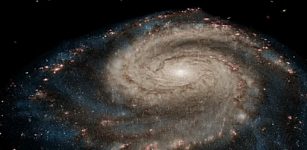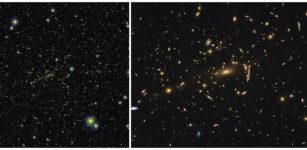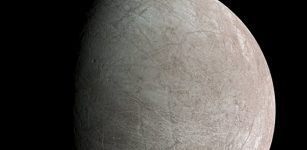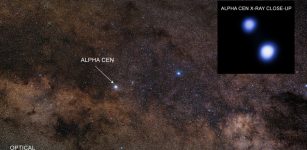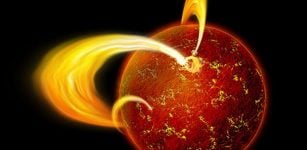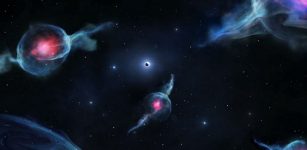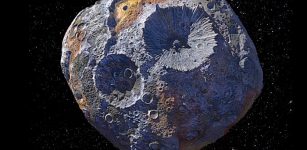New Hubble Data Explains Missing Dark Matter
Eddie Gonzales Jr. – MessageToEagle.com – Further evidence for tidal disruption in the galaxy NGC 1052-DF4 is now obtained from the NASA/ESA Hubble Space Telescope new data.
It explains a previous finding that this galaxy is missing most of its dark matter. By studying the galaxy’s light and globular cluster distribution, astronomers have concluded that the gravitational forces of the neighboring galaxy NGC 1035 stripped the dark matter from NGC 1052-DF4 and are now tearing the galaxy apart.
 This image shows the sky around the ultra diffuse galaxies NGC 1052-DF4 and NGC 1052-DF2. It was created from images forming part of the Digitized Sky Survey 2. NGC 1052-DF2 is basically invisible in this image. Credit: ESA/Hubble, NASA, Digitized Sky Survey 2 Acknowledgement: Davide de Martin
This image shows the sky around the ultra diffuse galaxies NGC 1052-DF4 and NGC 1052-DF2. It was created from images forming part of the Digitized Sky Survey 2. NGC 1052-DF2 is basically invisible in this image. Credit: ESA/Hubble, NASA, Digitized Sky Survey 2 Acknowledgement: Davide de Martin
Now, new Hubble data have been used to explain the reason behind the missing dark matter in NGC 1052-DF4, which resides 45 million light-years away.
The team discovered that the missing dark matter can be explained by the effects of tidal disruption. The gravity forces of the neighboring massive galaxy NGC 1035 are tearing NGC 1052-DF4 apart. During this process, the dark matter is removed, while the stars feel the effects of the interaction with another galaxy at a later stage.
Until now, the removal of dark matter in this way has remained hidden from astronomers as it can only be observed using extremely deep images that can reveal extremely faint features.
“We used Hubble in two ways to discover that NGC 1052-DF4 is experiencing an interaction,” explained Mireia Montes of the University of New South Wales in Australia in a press release. “This includes studying the galaxy’s light and the galaxy’s distribution of globular clusters.”
Hubble’s high resolution helped to identify the galaxy’s globular clusters population. The 10.4-meter Gran Telescopio Canarias (GTC) telescope and the IAC80 telescope in the Canaries, Spain, were also used to complement Hubble’s observations by further studying the data.
 This image presents the region around the galaxy NGC 1052-DF4, taken by the IAC80 telescope at the Teide Observatory in Tenerife. The figure highlights the main galaxies in the field-of-view, including NGC 1052-DF4 (center of the image), and its neighbor NGC 1035 (center left). Credit: M. Montes et al.
This image presents the region around the galaxy NGC 1052-DF4, taken by the IAC80 telescope at the Teide Observatory in Tenerife. The figure highlights the main galaxies in the field-of-view, including NGC 1052-DF4 (center of the image), and its neighbor NGC 1035 (center left). Credit: M. Montes et al.
“It is not enough just to spend a lot of time observing the object, but a careful treatment of the data is vital,” explained team member Raúl Infante-Sainz of the Instituto de Astrofísica de Canarias in Spain.
“It was therefore important that we use not just one telescope/instrument, but several (both ground- and space-based) to conduct this research. With the high resolution of Hubble, we can identify the globular clusters, and then with GTC photometry we obtain the physical properties.”
Astronomers also studied the galaxy’s light and found evidence of tidal tails, which are formed of the material moving away from NGC1052-DF4—this further supports the conclusion that this is a disruption event.
The additional analysis concluded that the central parts of the galaxy remain untouched and only about 7% of the stellar mass of the galaxy is hosted in these tidal tails. This means that dark matter, which is less concentrated than stars, was previously and preferentially stripped from the galaxy, and now the outer stellar component is starting to be stripped as well.
“This result is a good indicator that, while the dark matter of the galaxy was evaporated from the system, the stars are only now starting to suffer the disruption mechanism,” explained team member Ignacio Trujillo of the Instituto de Astrofísica de Canarias in Spain.
“In time, NGC1052-DF4 will be cannibalized by the large system around NGC1035, with at least some of their stars floating free in deep space.”
Astronomers believe the study has solved an astronomical conundrum.
“This discovery reconciles existing knowledge of how galaxies form and evolve with the most favorable cosmological model,” added Montes.
Written by Eddie Gonzales Jr. – MessageToEagle.com Staff


